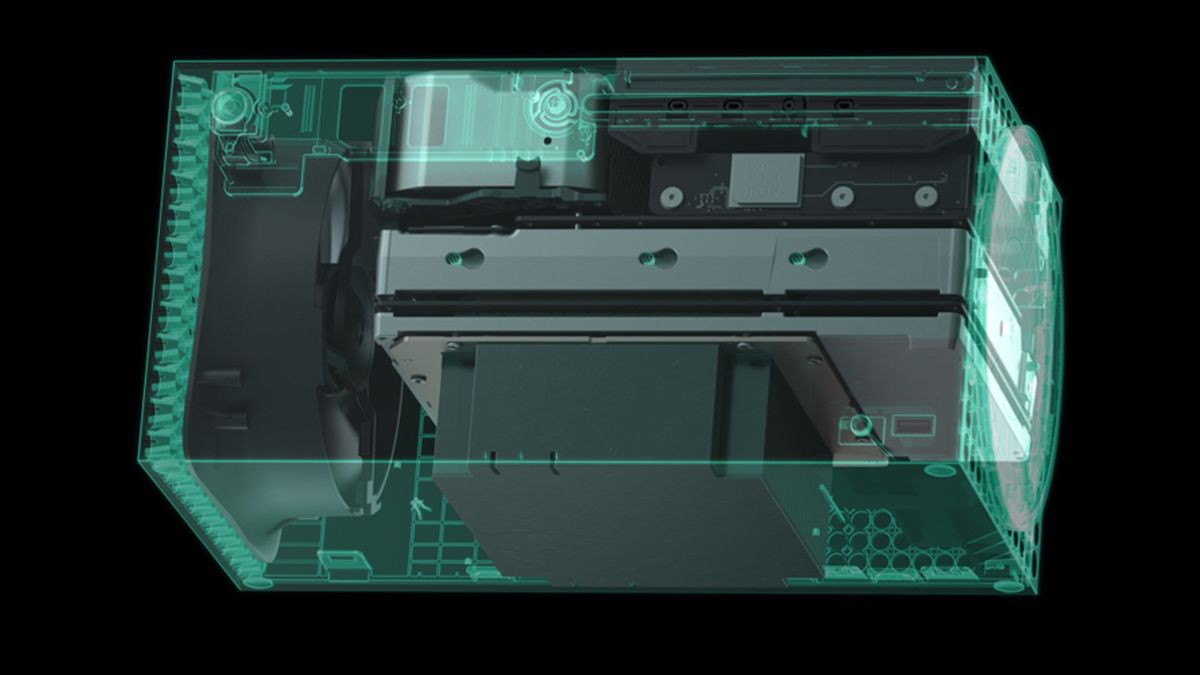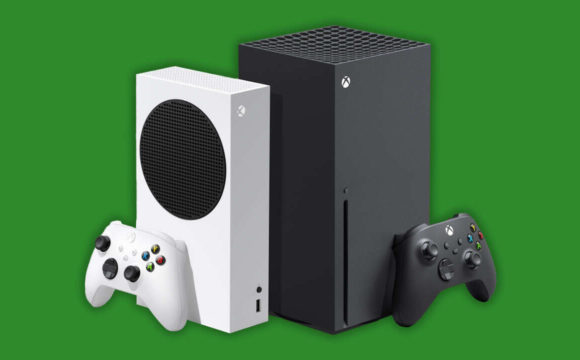
After seeing some next-gen games in action at long last, the power of the Xbox Series X specs is finally on display. In fact, this console has more horsepower under the bonnet than any we’ve seen before. Thanks to 12 teraflops of graphical wizardry and a super-fast SSD to improve load times, games will look better than ever.
If you need any proof, just look at the likes of Resident Evil 8: Village and Assassin’s Creed Valhalla. It’s a reminder that the Xbox Series X specs are on-par with the best gaming PCs of today. Indeed, they’re matched only by the PS5 specs. We’ve got no idea how either next-gen console is fitting all that tech inside such small boxes, honestly. Now that we’ve seen both designs, it’s staggering that they’ve managed to fit so much advanced machinery into this small a space.
Not that their power is news, of course. Microsoft has been very upfront about the Series X being the “most immersive console experience ever”, so it’s no surprise that their new console is stuffed full of cutting-edge technology. And considering what we saw from the Unreal Engine 5 tech demo, the best is yet to come; although it was running on a PS5, the same incredible visuals and seamless complexity will be possible on the Series X for any upcoming Xbox Series X games.
We’ve just got to hope we’ll be able to test it out ourselves soon; after rumours that the PS5 release plans and stock have been held up by COVID-19, we’re a little concerned that the Series X will also see a more limited launch than we’d like. Still, at least it’ll be worth the wait – there’s a lot of exciting tech hidden away in this new console. What’s more, recent comments from Xbox boss Phil Spencer indicate that the Xbox Series X price could be much more affordable than we expected. That’s certainly good news for our bank-balance.
To get more info about this next-gen console’s specs and tech, be sure to check out our write-up below. For the bigger picture on all things ‘Nextbox’, don’t forget to pop over to our dedicated guide on everything you need to know about the Xbox Series X.
Xbox Series X specs confirmed
(Image credit: Microsoft)
You ready? Let’s get technical. As per the recent Xbox.com post, Xbox Series X will feature eight Zen 2 CPU cores at 3.8GHz. That helps make the ‘Quick Resume’ feature possible, allowing users to “continue multiple games from a suspended state almost instantly”. When combined with 12 teraflops of GPU power, we’re left with a system capable of hardware-accelerated ray tracing. That means more realistic lighting, reflections, and sound.
What’s more, that Unreal Engine 5 demo showed that the Series X will be able to render unbelievably detailed, photo-realistic environments without a hiccup, not to mention exquisite, believable lighting and more immersive audio. It even offered immense draw-distances without stumbling, and without compromise. That would be flat-out impossible on today’s consoles.
4K resolution at 60FPS is another welcome addition, with the potential for 120FPS in certain games. What does that mean in a practical sense? That’ll result in a smoother, more detailed experience than we’ve ever had on a console before.
Microsoft is also throwing a Solid State Drive (or ‘SSD’) into the mix, allowing for lightning-fast loading. An example of this can be seen in the Xbox Series X loading times comparison video. More specifically, we now know for sure that the Series X is fitted with 1TB of internal storage thanks to an NVMe SSD.
This accompanies 16GB RAM, the option of expandable storage/external hard drives, and a 4K UHD Blu-ray disc drive. To translate, that’s enough grunt to give the Series X an advantage over its competitors, Google Stadia and Sony’s PS5.
Indeed, the recent reveal event for the latter gave us a good look at the PS5 tech… and showed that they’re trailing behind the Series X. Although Sony’s new CPU is only a few points below (it’s otherwise identical), the GPU is lagging by a few teraflops. More specifically, the PS5 graphics are comprised of 10.28 teraflops and 36 CUs at 2.23GHz. That’s quite a way behind Xbox’s 12 teraflops, even if the Series X equivalent’s 52 CUs are running at 1.825GHz.
Not that it’ll make a tremendous difference long-term, of course. As we mentioned in our write-up on PS5 vs Xbox Series X, games may look marginally prettier on Xbox but will be broadly similar in most other regards. And because the PS5’s CUs have more GHz to play with, it may all balance out in the end anyway. We’ll just have to wait to find out.
Something both systems have is speed, though. As mentioned above, their SSDs are incredibly quick. That’ll totally change the game for Xbox. Well, mostly. It’s worth pointing out that – as revealed by April’s surprise Inside Xbox stream – you won’t be able to load Xbox Series X games from most external HDDs or SSDs. In fact, you can only do so from the console’s own SSD or proprietary cards sold by Microsoft.
Still, that’s only one negative amongst a sea of positives. You can see the full Xbox Series X breakdown right here, courtesy of Xbox’s news blast:
(Image credit: Microsoft)
What we’re looking at is a console that will natively support up to 8K resolution and silky-smooth gaming experiences. If that wasn’t enough, Series X will also have support for variable refresh rate. It’s a notable feat, especially when combined with an SSD for quick loading and high-bandwidth DDR6 RAM that the company claimed will “usher in resolution and framerates we’ve never seen before” at E3 2019. Throw in superior HDMI 2.1 connections for a better picture and higher cable bandwidth of 48GBPS and you’ve got a very tempting package all-round.
Better wireless tech for controllers doesn’t hurt, either – Series X handsets will apparently be more responsive than ever before, reducing latency in a big way for a more instantaneous response. We’ve got the full story on Xbox Series X controller details here if you want more info.
So, to summarise: Microsoft is trying to define the next generation conversation early. By outlining the Xbox Series X specs well before the competition, they’re well and truly leading the charge. And it’s working; we’re pretty impressed by everything we’ve heard so far. The combination of the custom AMD architecture, DDR6 RAM, and SSD drive could well give us a console that feels truly revolutionary.
What about the rumors of a cheaper alternative, though? There have been whispers that the Xbox Lockhart price could be half that of Xbox Series X, after all. And although this should be taken with a massive pinch of salt, the PS5 Digital Edition reveal has proven that it’s possible. We’re going entirely on gut-instinct here, but that price would also imply a reduction in specs. Perhaps it’d forgo ray tracing and higher frame-rates to keep the cost down? We’ll have to wait and see.
The upshot of all that raw power is the fact that Xbox Series X will destroy loading times as we know them. In fact, the Microsoft video demonstration showed a Series X loading State of Decay 2 in around eight or nine seconds. That’s a full 35 seconds faster than the Xbox One X managed. Which may not sound like much, but it’s staggering when both are put side by side. The difference is night and day.
“We’ve created a new generation of SSDs… We’re using the SSD as virtual RAM,” Microsoft said during their reveal video a few months ago (linked up top). As demonstrated by the showcase we mentioned above, the result will effectively make long, boring loading times a thing of the past. In theory, this should boost core performance 40 times over what the current generation is offering in this department. That means your favorite games will become smoother and faster, ironing out creases for a better overall experience.
Basically? You won’t want to go back once you’ve got a taste. Not that you’ll have to, of course. It’s been revealed that Xbox Series X backwards compatibility will give access to four generations of Xbox games, meaning everything’s playable on your new system.
Xbox Series X specs – what does it mean for games?
(Image credit: Microsoft)
In terms of what this means for gaming, worlds will be bigger. Character models are going to become more detailed. Ray tracing should open the door for gorgeous, vivid lighting that’s leaps and bounds ahead of what we’ve got now. Gameplay in 4K at 60 frames-per-second (or 120FPS in some cases) will result in experiences that feel more immediate, more lifelike. We’re totally here for it, and you should be too.
With the Xbox Series X launch set for Thanksgiving 2020 (e.g. 26 November), all we can do now is wait for more details on the games we’ll be enjoying with this new console. Halo Infinite was the first to be confirmed, and it’s eye-catching enough as it is; created using 343 Industries’ new Slipstream engine, which is purpose-built to draw the most out of the next-gen system, it gives us only the smallest hint as to how detailed and beautiful gaming will be on Xbox Series X. We can’t wait.
Bring on the next generation!
A bit fuzzy on what ray tracing means for next-gen? Join us as we explore how important real-time ray tracing will be for Xbox Series X and PS5.








